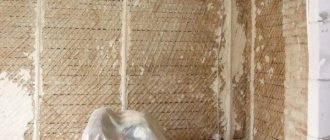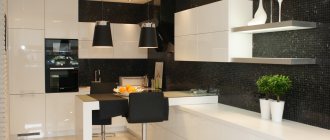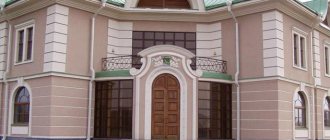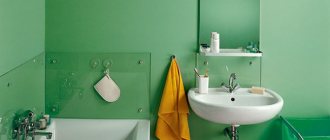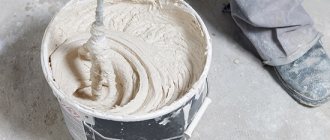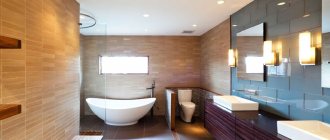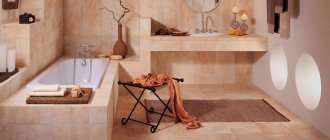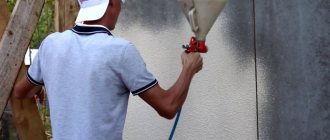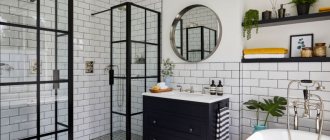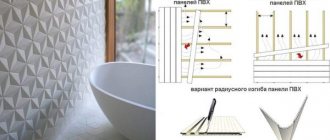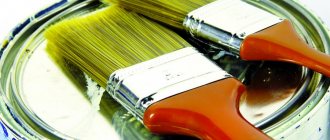Moisture-resistant plaster is used as a waterproofing protective barrier for the walls of basements and basements, bathrooms, toilets, swimming pools and facades.
It can be a leveling layer under tiles or an independent decorative coating.
Suitable for finishing structures made of brick, concrete, aerated concrete and stone.
Suitable for external and internal work.
Waterproof plaster. What is this
Waterproof waterproofing plaster is a finishing material intended for use in conditions of high humidity.
High moisture resistance is ensured by polymer hydrophobic additives contained in mortar mixtures.
The main advantage of moisture-resistant plasters is their vapor permeability, allowing the walls to “breathe”.
This property allows you to create a comfortable indoor microclimate and prevents the formation of mold on the walls and the development of microorganisms.
In rooms with moisture-resistant decorative finishes, glass and mirrors do not fog up.
Decorative plasters for wet rooms perform the function of a finishing finish that does not require additional coatings.
Review of manufacturers
You need to choose plaster from trusted manufacturers. Such enterprises care about quality and control processes at all stages of production.
These include brands:
- PLITONIT T1. Cement mixture with fibrous and water-repellent additives. High adhesion to brick, concrete, aerated concrete. Viability about 4 hours.
- KNAUF Grunband. The porous composition provides additional thermal insulation. Moisture-resistant compositions are characterized by a uniform texture and low consumption. Disadvantages include low strength.
- WEBER VETONIT TT 40. The cement mixture is used on expanded clay and porous stone walls. Can be applied up to 4 – 5 cm thick, starting from 5 mm. The result is a durable finish with moisture-resistant qualities and resistance to negative temperatures.
- CERESIT CT 29. A quality compound can be leveled so that finishing is not required. The recipe contains reinforcing fiber and polymer modifiers. It is expensive and prone to cracking;
- VOLMA Layer. Domestic mixture for plastering with moisture-resistant characteristics. The dried layer has a glossy surface and adheres well to the base. The composition is classified as environmentally friendly products.
A Russian manufacturer produces a waterproof solution KREPS Master , which is suitable for various surfaces. It is applied mechanically or manually, resulting in a durable layer. The disadvantages include the low viability of the mixture.
Classification of waterproof plasters
Waterproof plasters are divided into leveling and decorative.
Leveling waterproof plaster creates a reliable and durable base for further tiling with ceramic tiles or painting with moisture-resistant paints.
For decorative finishing of damp and damp rooms, Venetian plaster coated with special protective wax is widely used. This finish is not inferior to tile cladding in terms of moisture-resistant properties. Venetian plaster is the most difficult to apply and expensive decorative coating.
Required Tool
To level the surface of the wall, as well as for finishing, you will need ordinary plastering tools and devices, namely:
- Master OK;
- grater;
- putty knife;
- rule;
- trowel;
- brushes;
- rollers;
- mixer, masking tape;
- containers;
- level;
- plumb line;
- installation of beacons.
Recommendations for choosing formulations
The choice of waterproof plasters depends on the type of coating, base material, application method and financial capabilities of the owner of the building.
If a covering under tiles is required, perfect alignment and high strength of the base are required. These conditions are fully met by cement or cement-polymer mixtures.
Knauf or Ceresit plaster mixtures intended for wet rooms are suitable for painting with waterproof compounds. Additional protection from moisture will be provided by applying a thin layer of Aquastop primer.
The most suitable decorative finish for wet rooms is Venetian, which has high waterproofing properties due to the application of protective wax coatings.
Surface preparation
Before applying a waterproofing coating, the base must be cleaned of oil stains, areas of biological damage, dirt, paint, crumbling parts of the old coating, and dust. Biocidal compounds are used to neutralize the fungus. Sinks whose dimensions exceed 3 cm are leveled with non-shrinking cement mortar.
Cracks and crevices are embroidered and caulked with the same solution. Excessively uneven surfaces are leveled in advance. The corners where the wall and floor meet are rounded with fillets made of cement plaster composition. Radius – 3-4 cm. Smooth concrete surfaces are covered with notches.
Cement mixtures
Cement mixtures are made from cement and sand with the addition of hydrophobic modifying additives and plasticizers.
Cement plasters for wet rooms are highly durable and water resistant.
It is better to purchase ready-made dry mixtures, presented in a wide range on the construction market, in which all components are perfectly balanced:
- EC waterproofing mixture, for plastering on stone and brick;
- Ceresit CR 65 - for any base;
- AZOLIT-VSH - for finishing on concrete and brick;
- Profit Gidrofob for applying an additional waterproofing layer on plastered bases;
- Murexin Waterproofing Hydro Basic 1K, suitable for all substrates;
This solution should be prepared in accordance with the recommendations on the packaging, using a construction mixer or a hammer drill with an attachment for mixing.
To make cement mortar with your own hands, you need to take a mixture of cement and sand in a ratio of 1:3, add PVA glue to increase water resistance and washing powder to increase ductility.
The best way to plaster the walls in the bathroom
When determining the type of material that will be ideal for a particular situation, you need to take into account the features of finishing the walls in the bathroom.
Under tiles
Unlike a layer of paint, tiles provide additional waterproofing to the walls, reliably protecting them from moisture penetration. When tiling walls, you can use both cement and gypsum compositions, although the latter come with a number of reservations. Gypsum, in comparison with cement, has less strength, therefore, with a large weight of ceramics, the plaster layer can simply fall off. If there is a need to use gypsum plaster, it will have to be coated 2-3 times with primers or deep penetration primers.
In addition, during long-term use, when the seams between the tiles begin to gradually weaken, the risk of moisture penetration under the tile increases. Gradually, the gypsum plaster begins to deteriorate. There is another dangerous property of gypsum that appears when it comes into contact with tile adhesive: it can form the mineral substance ettringite. The latter provokes the so-called sulfate corrosion of concrete, as a result of which the wall deteriorates greatly.
Cement plasters should be used for laying tiles.
Therefore, you will have to make the protective barrier between the gypsum plaster and the tile more reliable, and cover the seams between the individual elements with high-quality silicone sealant. This is the only way to make plaster in the bathroom moisture resistant. To avoid such problems, it is better to use cement plasters with the addition of polymer components that reduce the risk of cracking.
For painting
Painting the surface requires obtaining perfectly smooth walls, because any paint will only highlight all the pits, chips, irregularities, and scratches. Of course, gypsum mixtures make it possible to obtain a smoother base, but a thin layer of paint will not protect them from moisture. Even with minor damage, the plaster will begin to deteriorate and peel.
Cement-based finishing plasters are used for painting in the bathroom.
If you decide to paint the walls in the bathroom, you need to plaster them with reliable cement mixtures. The strength and moisture resistance of cement allows for high-quality and durable repairs. After applying the rough layer, it is necessary to carry out finishing putty with finely dispersed compounds, which are then sanded until smooth. If you have free funds for work, you can use any polymer plasters that have all the necessary properties.
Compositions with polymer additives
Moisture-resistant compositions based on polymer fillers have high water-resistant properties, strength and ductility.
The most popular mixtures:
- Profit Barrier, ideal for the base under ceramic tiles;
- Hydrophobic water-repellent plaster Dufa Kratzputz aussen, acrylic based, suitable as decorative plaster for wet rooms. It has an original texture similar to orange peel;
- Dry moisture-resistant mixtures STUC DECO and STUC GRANITO, based on polymers, can be used as a finishing decorative coating.
Specifications
The use of frost-resistant plaster is especially important in regions where very low temperatures prevail in the winter and very high temperatures in the summer months.
As a result of such negative influence, the surface of any building and structure experiences additional load.
A particularly difficult situation can arise when the facade covering has a high level of moisture absorption, as a result of which the absorbed water, freezing, increases in volume and tears the finish.
Naturally, the building in this case loses its original appearance and requires mandatory repairs.
IMPORTANT!
Therefore, in order to ensure the safety of the structure and ensure a long service life, finishing materials should be used that will have the necessary technical characteristics.
Frost-resistant putty is an ideal solution in this case, since it has properties that fully satisfy the future operating conditions of the building.
Let's consider all these properties in more detail, for which we will make a small table:
| Property | Description |
| Absorbs moisture in minimal amounts | The composition easily prevents mechanical destruction of the building, also prevents the formation of mold and increases the heat-saving characteristics of the overall structure. It should be noted that when moisture is absorbed, many materials lose their qualities as a heat-insulating material, therefore, insulation materials cannot cope with this problem; in this regard, it is necessary to use putty that does not absorb moisture. |
| Excellent resistance to low temperatures and does not burst in the cold | The material fully retains its properties even when frozen and after defrosting, regardless of what temperature conditions are observed. It is important that qualities can be maintained over many cycles. |
| Good steam permeability | An important point to consider when finishing is that the materials (wood, brick or aerated concrete blocks) must “breathe”. If the base of the building is made of these materials, then it is necessary to ensure a complete escape of water vapor and the house to the outside. If this does not happen, then moisture will accumulate under the putty and as a result mold will form, the wood will begin to rot and the structure will quickly become unusable. |
| Not susceptible to mechanical stress | After the putty has hardened, it should acquire a new quality that will allow it to successfully withstand various mechanical influences - scratches, impacts, and other damage. |
| Environmentally friendly mixture | This characteristic is especially important for materials that are used for interior decoration, however, when performing exterior decoration, environmental safety is also an important parameter. It is better to carry out finishing using environmentally friendly compounds that are not capable of causing harm to the human body either during finishing or after its completion, during the operation of the house. |
In addition to these characteristics, indicators such as elasticity and ease of application of the material . When choosing putty, you need to take into account the type of binder, its cost and manufacturer. It is best to purchase finishing from trusted companies, as this guarantees high quality of the finished product.
Technology of working with moisture-resistant plaster
Before starting work, it is necessary to clean the base from old finishing coatings, deteriorating layers, dirt and dust.
Before plastering brick walls, clean the masonry seams from mortar to a depth of 5-10 millimeters, for better adhesion of the coating to the wall.
When leveling plastered walls, make shallow notches on the surface using a chisel.
When plastering concrete walls, apply notches at least 3 mm deep using a grinder with a diamond wheel or a hammer drill with a spatula attachment.
Cover the wall with primer twice. The second layer is applied after the first has completely dried.
Plaster mixtures for wet rooms must be prepared immediately before starting work, strictly following the dosages and manufacturing instructions.
Application of the solution
The technology of plastering with moisture-resistant compounds involves applying three layers to the wall: spray, primer and cover.
The first layer, the spray, is made from a solution with a creamy consistency. We throw it on the wall using a trowel in any order. The solution applied in this way fills all cavities and voids.
Lightly level the first layer, removing protruding areas.
The thickness of the spray for brick and concrete walls should be no more than 5 millimeters. For wooden walls - 10 millimeters.
The second layer - apply the primer no earlier than a day after the spray has dried. The soil is the main layer, the thickness of which can reach three centimeters. We apply the moisture-resistant solution with a wide spatula or throw it on with a trowel and pull it from bottom to top, using the rule, with zigzag movements along the beacons.
The third layer is a covering, 1.5-2 millimeters thick, applied after the previous layer has hardened onto a pre-wetted surface and smoothed over the surface with wave-like movements using a trowel or wide spatula.
Without waiting for the moisture-resistant finishing layer to dry, we grout it in a counterclockwise circular motion with a wooden or plastic trowel.
The final sanding is done with a grater with felt attached.
During subsequent tiling, grouting of the plaster is not necessary.
Do I need to plaster the walls in the bathroom?
Plastering the walls in the bathroom is a mandatory stage of finishing work, which allows you to correct wall defects and eliminate all irregularities. Without plaster it is impossible to level the base, therefore it is impossible to lay the finishing materials beautifully. If the walls are not smooth, they cannot be painted, and there may be certain problems with installing plumbing and hanging furniture. Simply put, the aesthetics and functionality of a room largely depends on the quality of the plastering of the bathroom walls.
Aligning bathroom walls with tiles
It is a mistake to think that tile adhesive can cope with uneven surfaces if applied in large quantities. The adhesive composition must be applied strictly according to technology and in a fairly thin layer - only in this case it will not crack, and the tile will be securely held on the wall. Plastering can be avoided only if the walls are sheathed, for example, with moisture-resistant gypsum plasterboard, OSB or plastic panels. In this situation, they are already smooth and do not require applying a solution.
Tips and tricks
- Decorative finishes for wet rooms should be chosen with the least pronounced textures. You should not use decorative plasters of the “bark beetle” type, in the grooves of which, under conditions of high humidity, microorganisms can accumulate and mold and mildew can develop.
- Surfaces in direct contact with water are best tiled.
- To prevent the formation of mold on decorative plaster, add antiseptic compounds to the composition when mixing or use primer mixtures that already contain them.
- When preparing plaster mixtures yourself, strictly follow the dosages of the components and recommendations for their production.
- Adding liquid glass to the solution will help improve moisture-proofing properties.
Types of waterproofing
A waterproofing layer created in different ways becomes a barrier to moisture. Depending on the method and materials used, waterproofing can be:
- painting (applying layers of bitumen, resins, rubber);
- impregnation (application of compounds that penetrate deep into the pores of structural materials);
- coating (coating with hot bitumen compounds);
- mastic (applying an adhesive mass with fillers - mastic);
- injection (pumping special impregnating compounds into holes and cracks);
- pasting (sticker of rolled bitumen or resinous materials);
- plastering (plaster compositions allow you to additionally insulate the structure);
- backfill, for example, backfill with bentonite clay;
- film (use of anti-condensation films);
- cast (hot or cold pouring of mixtures in several layers);
- mounted (installation of hydromembranes).
Types of waterproofing
Also, depending on the location, a distinction is made between internal and external waterproofing.
Individuality of implementation method
Build waterproofing consistencies differ in their features of use and composition. With all this, they are divided into a number of types according to the following aspects:
- By type of material: roll (film, roofing felt), powder (build-dry consistency), watery.
- By chemical composition: polyethylene, cement, bitumen, rubber, acrylic, PVC materials, silicone (silicon).
- By method of implementation: sealing, penetrating, coating, membrane.
As you can see, waterproofing has many types, each of which has its own characteristics of operation outside and inside the premises.
Outside the buildings
When applying waterproofing, it is very important to take into account the air temperature and the amount of sunlight on the base. Consistencies are used at temperatures from +50C to 350C. Excessive sunlight negatively affects the applied powder or waterproofing, because it forces the water from the solution to evaporate very quickly. As a result of the hydration reaction, the composition will not acquire the declared features and will not be able to perform its functions. Therefore, the workspace must be protected from solar radiation.
Inside the premises
The main indicators for internal implementation are environmental friendliness and fire safety.
Therefore, materials made of PVC, bitumen, and rubber are not recommended for interior work. From time to time they cause allergic reactions. There is also one fundamental highlight of the introduction of waterproofing in rooms, which our builders forget about. Any powder or water-based composition provides excellent protection against water penetration on surfaces, but does not work well in corners. Therefore, at the junction of vertical and horizontal surfaces treated with insulation, a special membrane tape with an elastic non-penetrating gasket in the center must be used.
